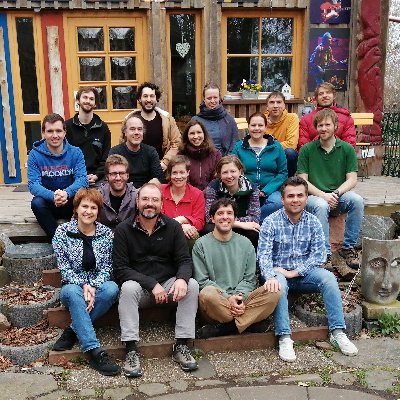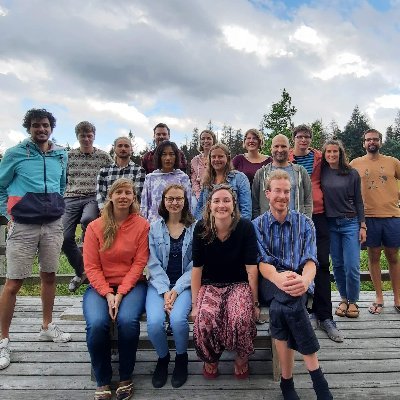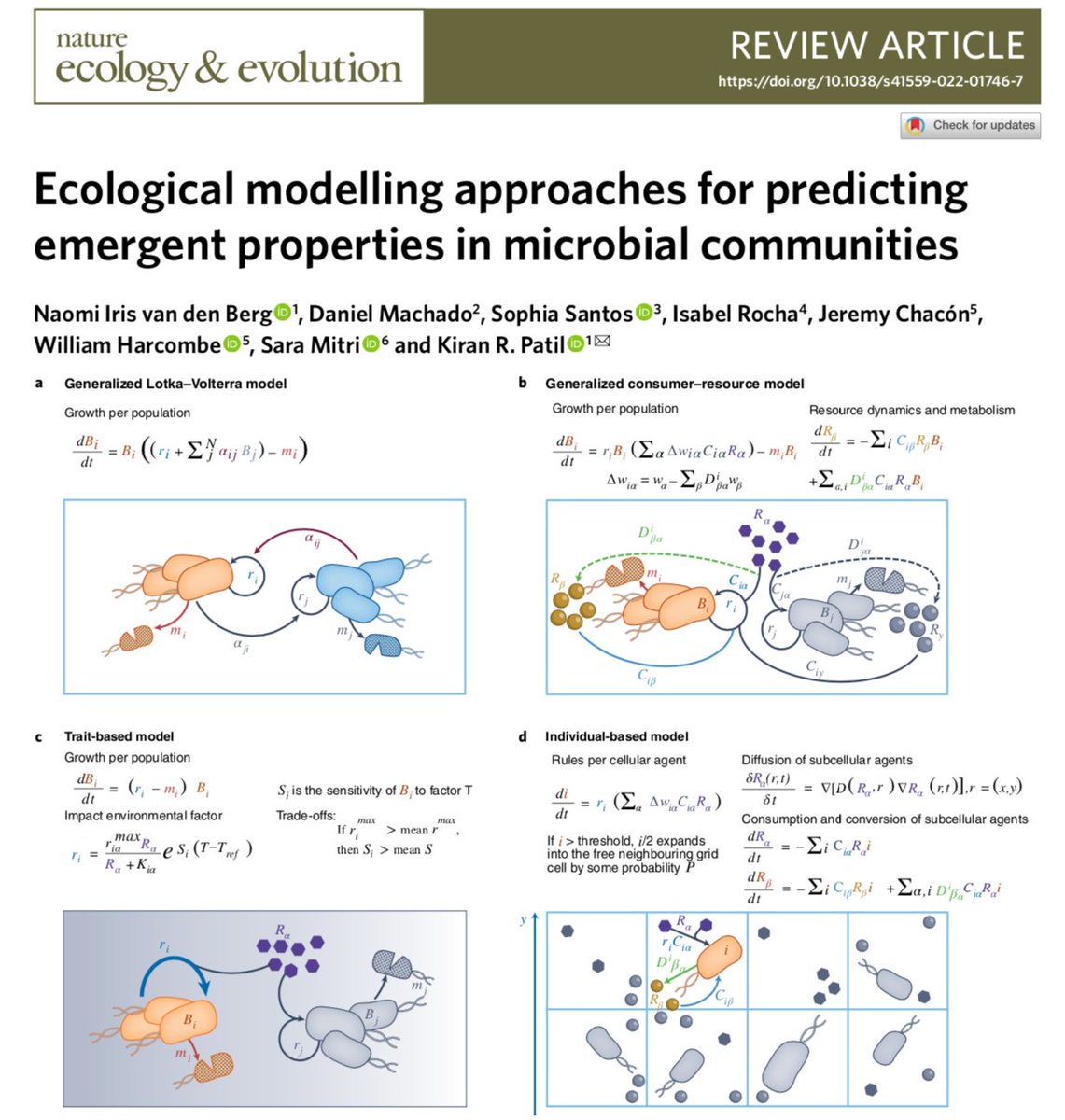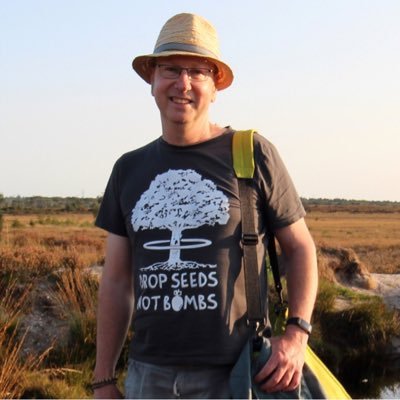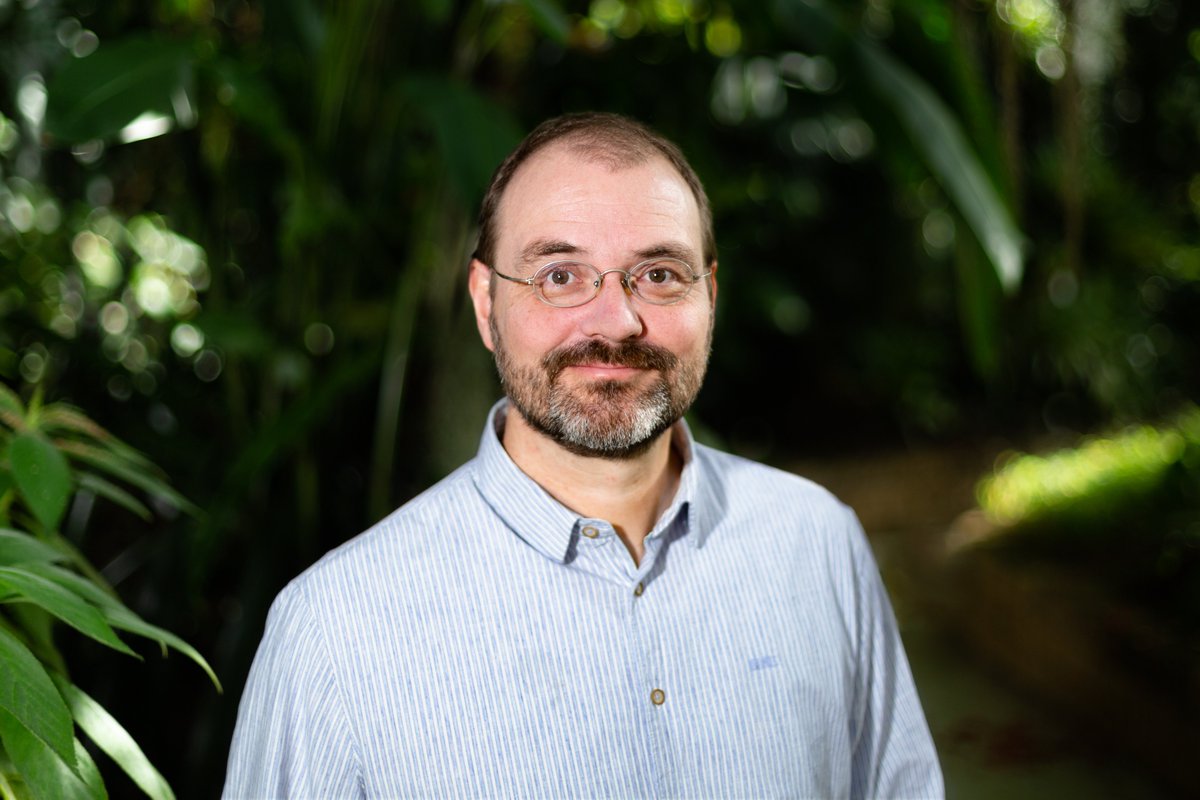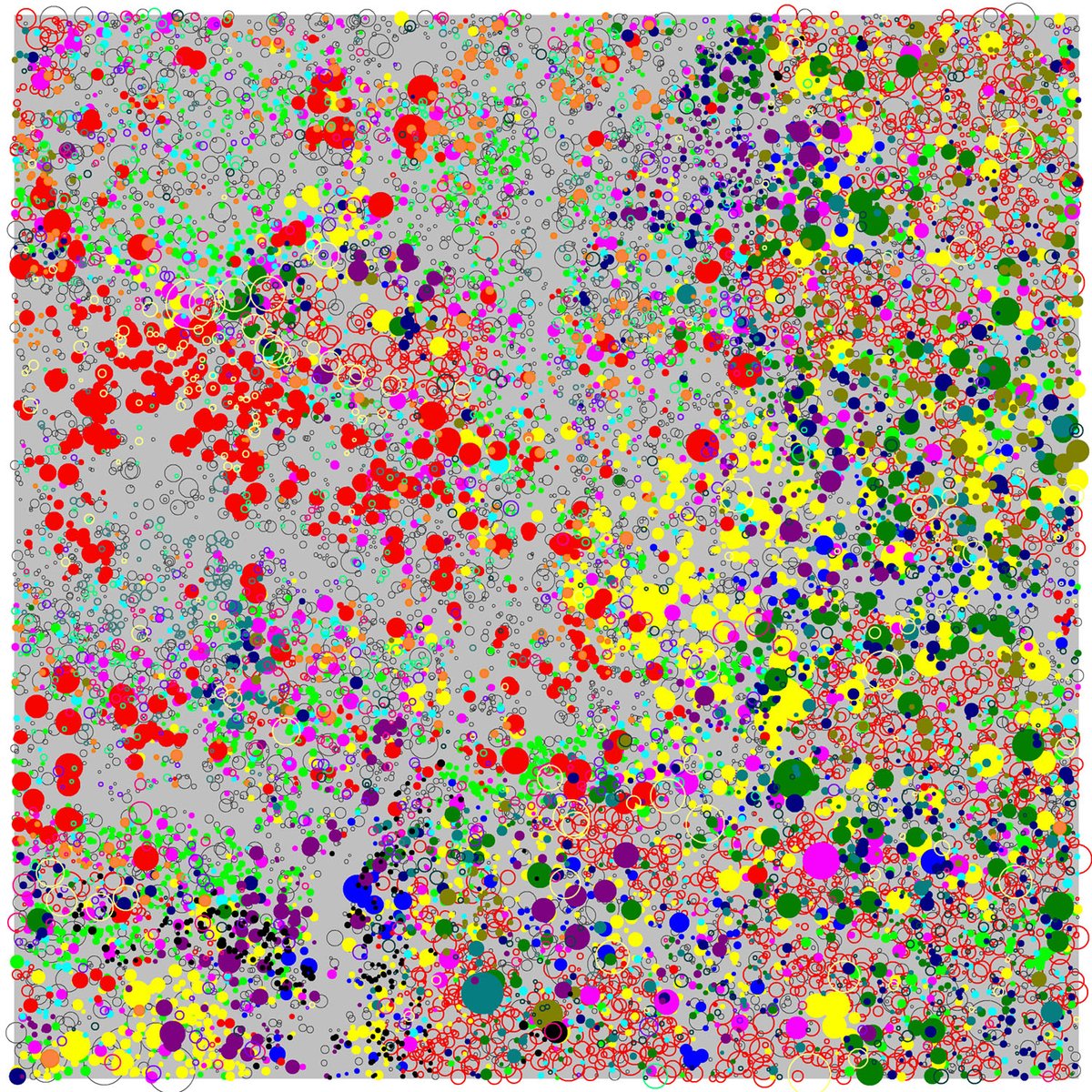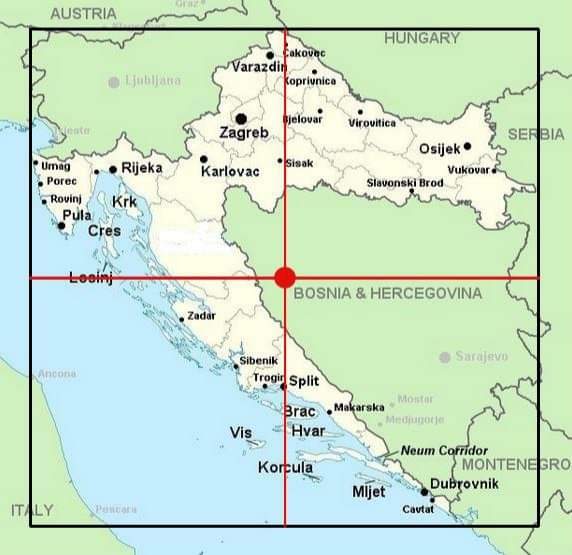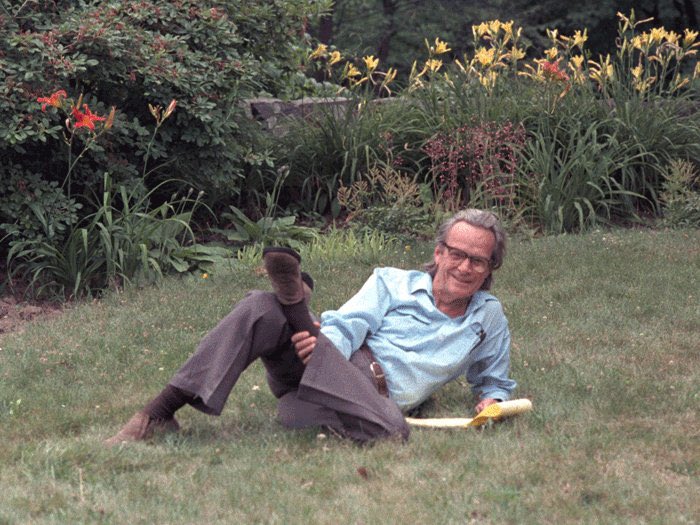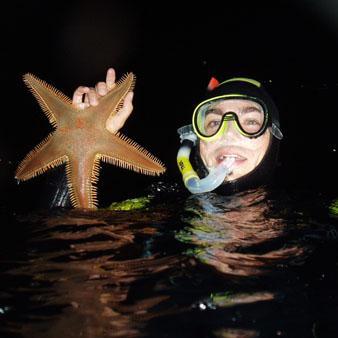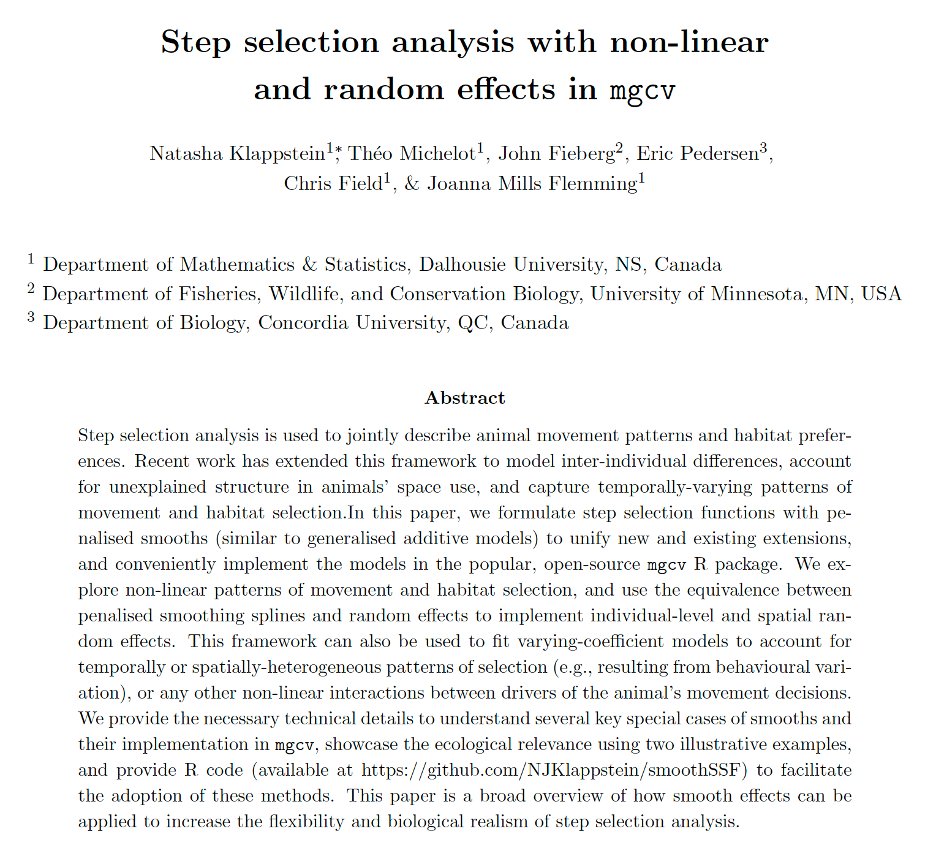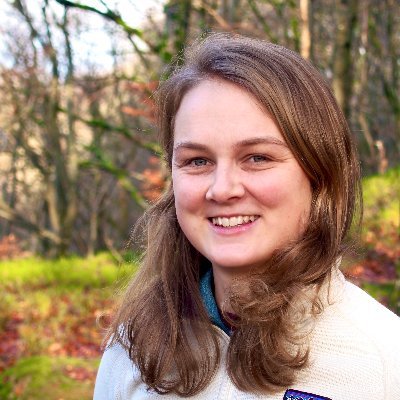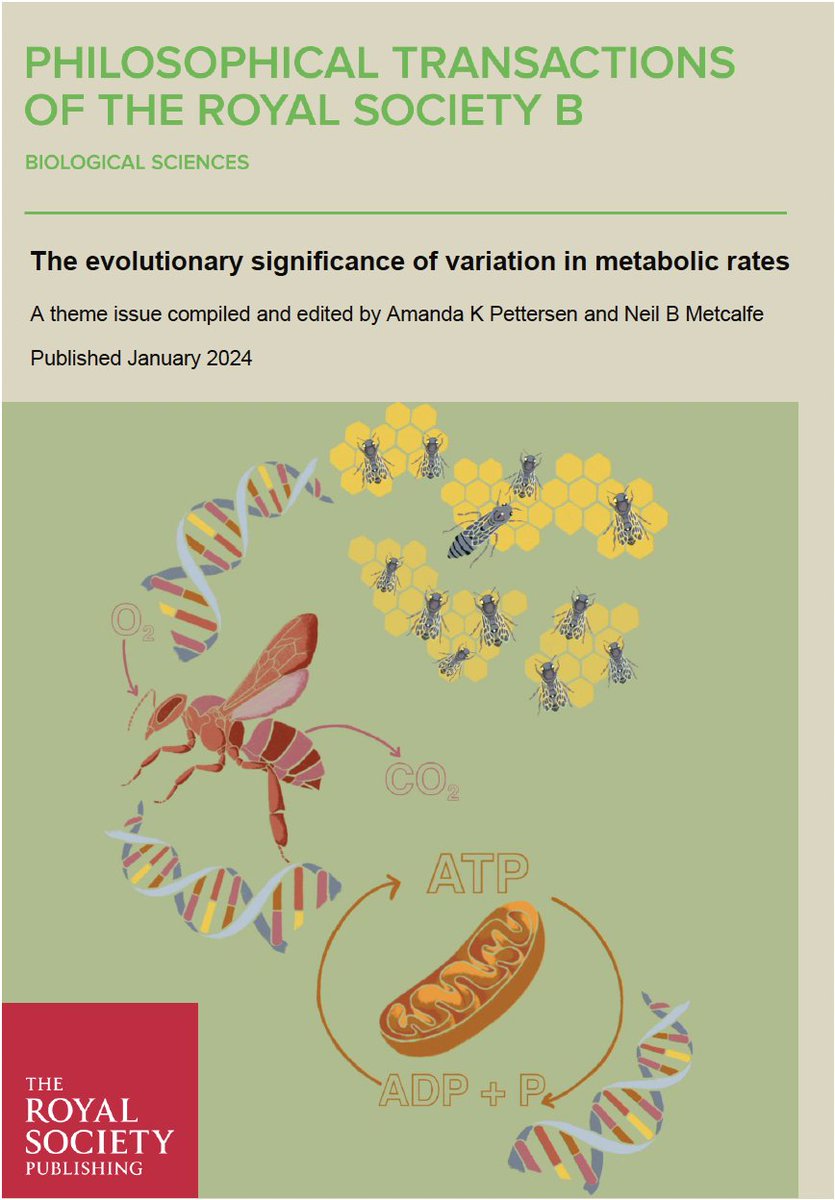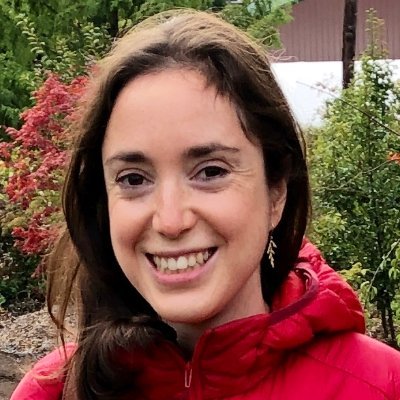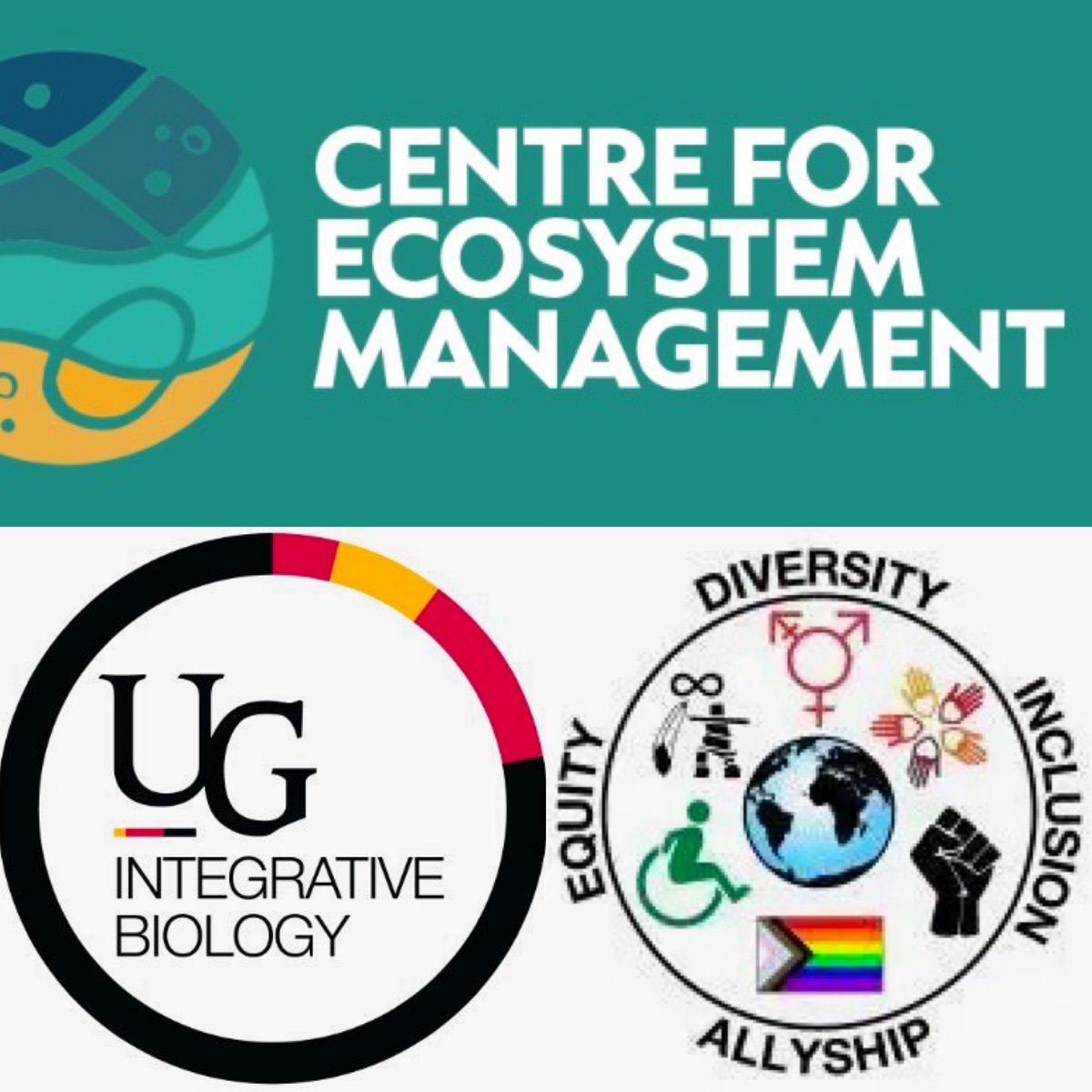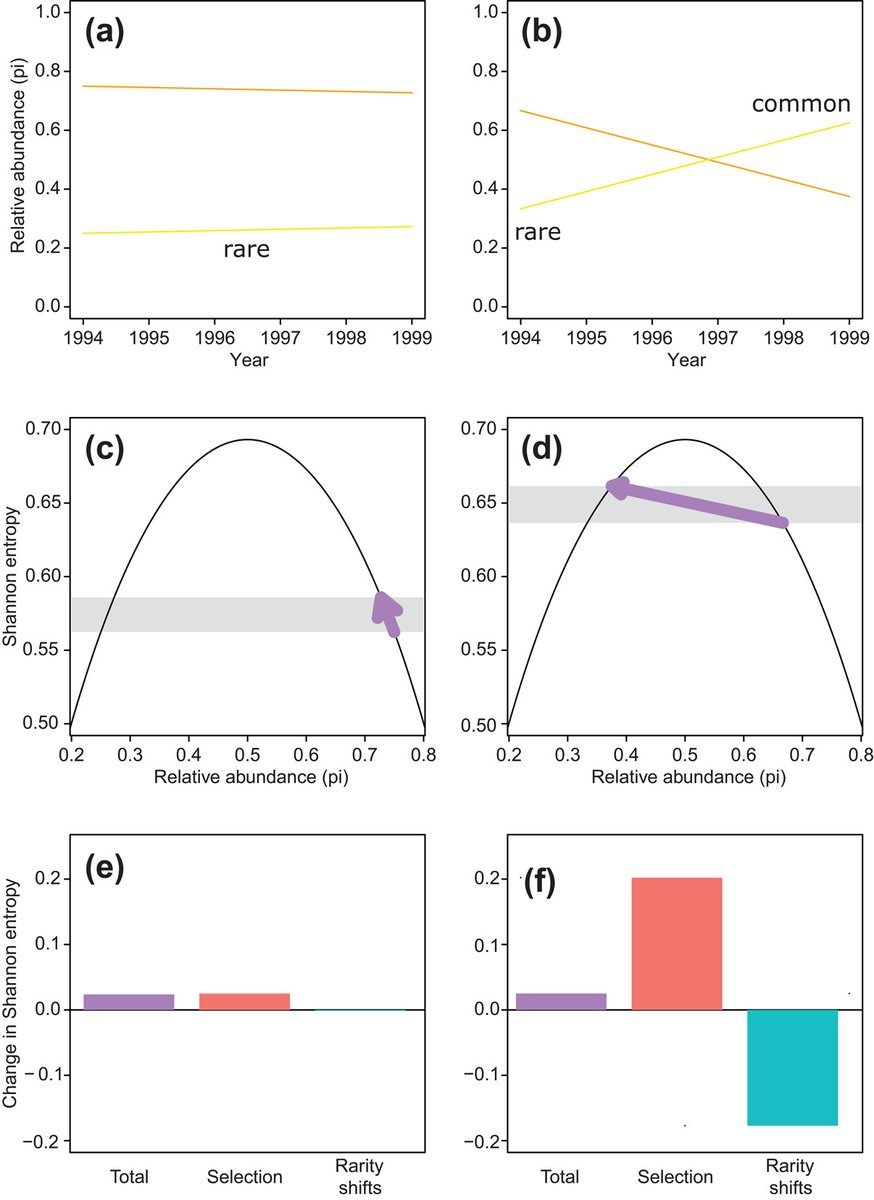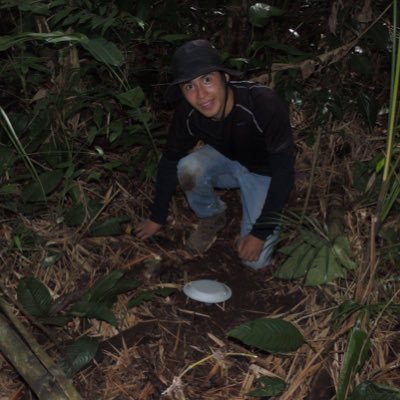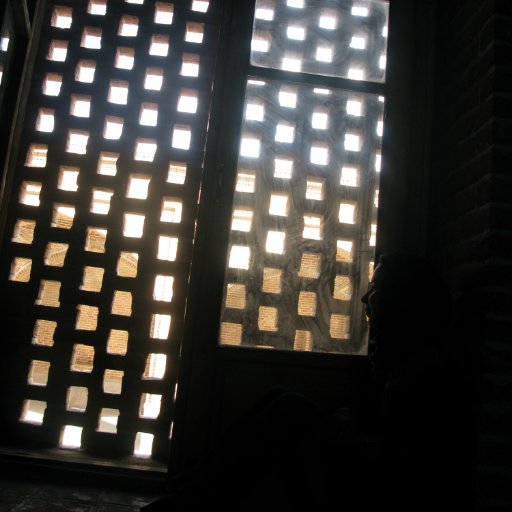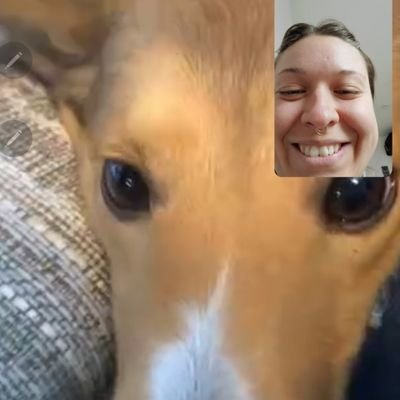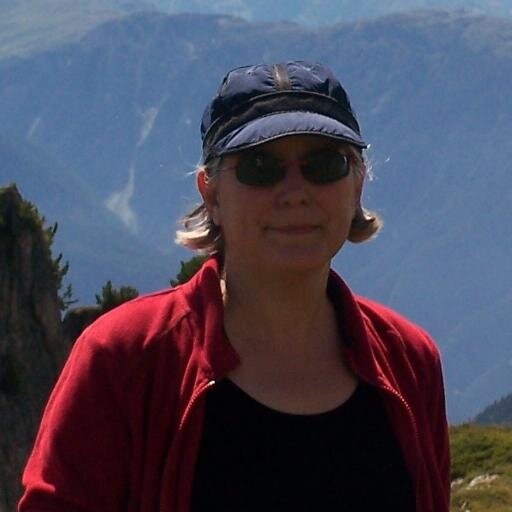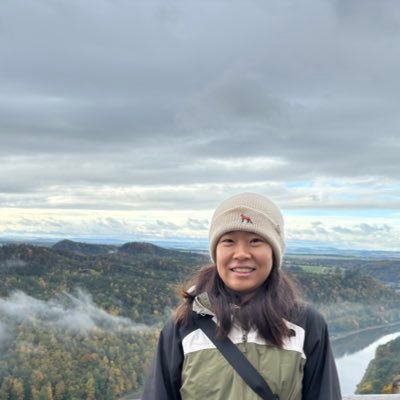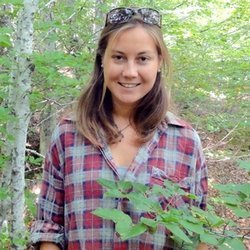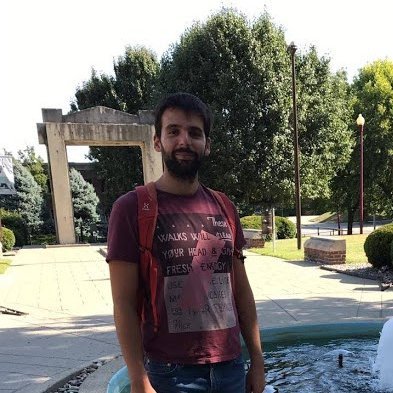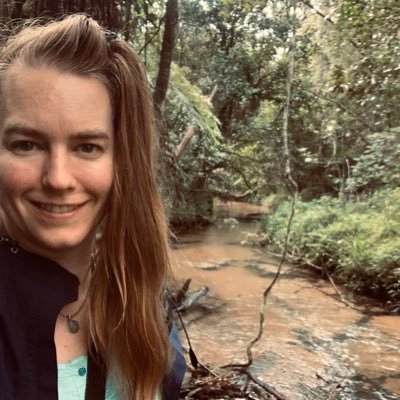EcoNetLab @EcoNetLab
Working group @idiv led by Ulrich Brose addressing the structure, dynamics and functioning of trophic and spatial networks idiv.de/econetlab Leipzig, Germany Joined May 2016-
Tweets1K
-
Followers2K
-
Following265
-
Likes393
If you are interested in a postdoc position working on ecological networks - see this: jobs.uni-jena.de/jobposting/2e8… PRT
How can we model the emergent complexity of microbial ecosystems? How to do the maths & predict their dynamics, from the gut & the soil to the biosphere? Here's a great @NatureEcoEvo review @vdlorenzo_CNB @BCNCollab @ftmaestre @VictorVmaull @saramitri nature.com/articles/s4155…
I was just thinking someone needs to write a paper saying it is not biodiversity per se, but *species interactions*, that underpin ecosystem services This new paper makes that point, although I think there is much more to say on the subject besjournals.onlinelibrary.wiley.com/doi/full/10.10…
Herzlichen Glückwunsch an iDivs Gründungsdirektor, Christian Wirth, der heute in die @SAW_Leipzig aufgenommen wurde. 🎉Seine Arbeit hat das Verständnis von pflanzlicher #Biodiversität und Ökosystemprozessen erweitert. @agwirthweigelt @MPI_BGC @UniLeipzig idiv.de/de/news/news_s…
Herzlichen Glückwunsch an iDiv-Mitglied Dr. Thorsten Wiegand! 🎉 Der Ökosystemmodellierer vom UFZ bekommt den renommierten ERC Advanced Grant 2023! 🌟 @UFZ_de @ERC_Research @idiv #biodiversität
And this folks, is why you don't use posterior means to make predictions
We tend to use simple models to describe regime shifts in nature. But ecosystems, brains or cancers are built upon many interacting units. How does multistability emerge in complex systems? now in @Ecology_Letters ! @sonia_kefi shorturl.at/ADFP4
Noch mehr 'news coverage' über unsere aktuelle Studie in @NatureClimate zu den Effekten von steigenden Temperaturen auf das Jagdverhalten von Fischen @idiv @BGauzens @EcoNetLab @SusanneKortsch tagesschau.de/wissen/klima/f… #klimawandel #artenvielfalt #fische #wisskomm
Meine Meinung bleibt, dass die Politik den Wissen schaftlichen Prozess nicht versteht, weil sie nicht zuhört. Einzig in der Politik werden Eigentore gefeiert. #WissZeitVG
Meine Meinung bleibt, dass die Politik den Wissen schaftlichen Prozess nicht versteht, weil sie nicht zuhört. Einzig in der Politik werden Eigentore gefeiert. #WissZeitVG
Und das geht und allen in der Wissenschaft genau gleich. Wie schaffen den ganz grossen Braindrain und schaffen die systematische Arbeit an den Unis ab. #WissZeitVG
Und das geht und allen in der Wissenschaft genau gleich. Wie schaffen den ganz grossen Braindrain und schaffen die systematische Arbeit an den Unis ab. #WissZeitVG
Das @BMBF_Bund hat aus dem Kommunikationsdesaster um #IchbinHanna gelernt und kommuniziert mit Forschenden endlich auf Augenhöhe.
Living in a completely parallel universe, they call this an improvement... #WissZeitVG
Living in a completely parallel universe, they call this an improvement... #WissZeitVG
Absolutely cool project in a lovely new group. I would not hesitate to apply. Deadline soon...
My first PhD chapter is out as a preprint! We formulate step selection functions as GAM-like models, which can be fitted in mgcv. This allows for the inclusion of non-linear effects/interactions, as well as individual-level and spatial random effects! doi.org/10.1101/2024.0…
PhD Position on tree-tree interactions. We are looking forward to seeing your applications until January 17th.
PhD Position on tree-tree interactions. We are looking forward to seeing your applications until January 17th.
Thrilled to see our @PhilTransB theme issue on variation in metabolic rates published today! 🔥 …ing-org.ezproxy.library.sydney.edu.au/toc/rstb/2024/… A thread on the contributed papers: 1/8
Come join us!! If you worry you don’t quite fit the job ad - don’t worry, you do! Please apply!
🦋Published this week🦋 The first study to compare thermoregulatory abilities and mechanisms between #butterfly communities under different climatic conditions but with overlapping species composition Read the open access article: doi.org/10.1111/1365-2…
A mismatch between community assembly and abundance-based diversity indices nsojournals.onlinelibrary.wiley.com/doi/full/10.11… #biodiversity #species_richness #models #ibsprague2024 @NordicOikos

@smartenwinter.bsky.s... @sMarten_Winter
4K Followers 4K Following Ecologist | Head of iDiv's Synthesis Centre sDiv https://t.co/amXvLFoiDQ | https://t.co/HexIoHT60X | Highly Cited | TEDx https://t.co/gNw4C4tXdw| Drums https://t.co/7JwW3Ve8XS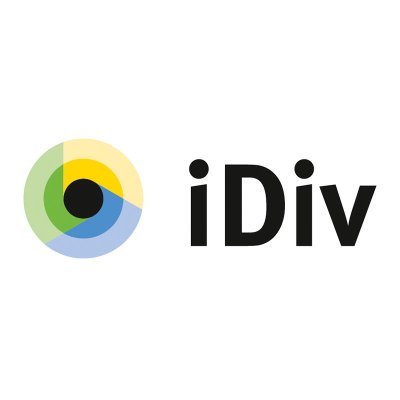
iDiv Biodiversity Res... @idiv
10K Followers 475 Following German Centre for Integrative Biodiversity Research (iDiv). Posts by iDiv’s Media & Communications unit. Imprint: https://t.co/nuf0cnroer
Fernando T. Maestre @ftmaestre
13K Followers 736 Following Professor of Environmental Science and Engineering @KAUST_news Husband, father, dryland ecologist & runner. PI @Maestrelab
Matthias C. Rillig @mrillig
15K Followers 1K Following Professor (Ecology) ML MAE, FU Berlin | soil | fungi | biodiversity | mycorrhiza | global change | microplastic | AI effects | YouTube: Life in Academia
Oscar Godoy @Eco_Godoy
3K Followers 1K Following Ecologist working on biotic interactions, multitrophic coexistence, and ecosystem functioning across terrestrial and marine systems #ecology @ebdonana @CSIC
Pete Manning @PeteEcology
4K Followers 2K Following Professor of Ecology, studying biodiversity, the functioning of ecosystems and the benefits they bring @UiB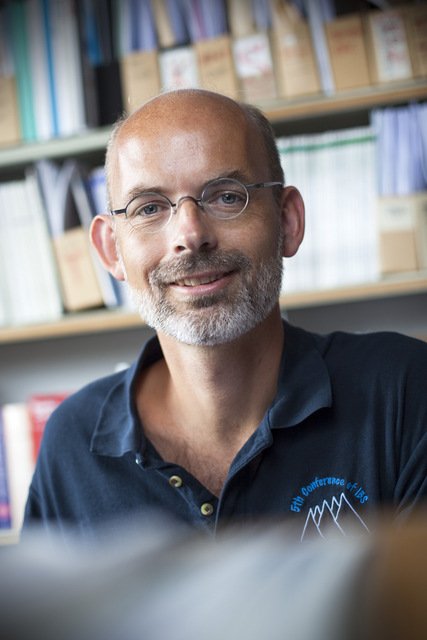
Jens Svenning @JCSvenning
11K Followers 2K Following Scientist: #macroecology, #biodiversity, #climatechange, #restoration & #rewilding, #human-#nature relations & #remotesensing. https://t.co/7Ylw5Z3Uw4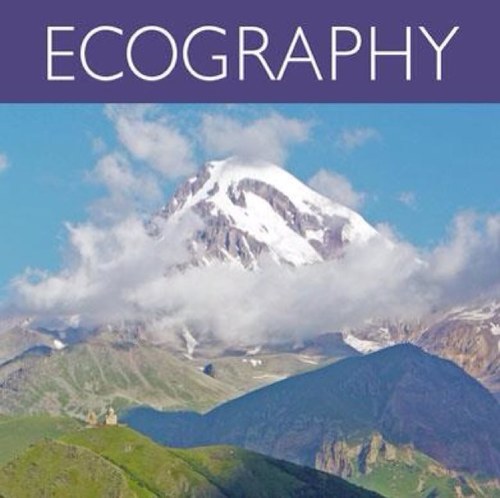
Ecography @EcographyJourna
16K Followers 1K Following An outlet for empirical/theoretical work in spatial and temporal #ecology, #macroecology and #biogeography. Owned by the @NordicOikos Society. #OpenAccess
Andy Gonzalez @bio_diverse
8K Followers 1K Following Biodiversity scientist | Liber Ero Chair @McGillU | co-Chair @GEOBON_org | co-Dir. @csbq_qcbs | cofounder @habitat_nat | Dad x2 | @[email protected]
Henrique Pereira @hmlfpereira
4K Followers 940 Following Professor of biodiversity conservation @iDiv @UniHalle, invited researcher @CIBIO_InBIO 🇵🇹🇩🇪🇪🇺
Richard McElreath �... @rlmcelreath
46K Followers 2K Following Director @MPI_EVA_Leipzig. Bayesian evolutionary anthropologist. Mostly absent from this site while writing books and maiming code.
Anton Potapov @AntonCollembola
1K Followers 497 Following 🇺🇦🧍❤️🩹🧍🇷🇺 | Re-visioning soil food webs at Senckenberg Görlitz | @idiv | #SoilBON https://t.co/8qO6ZFgUlF | #GlobalCollembola | https://t.co/IdsDReWLcf
Dr Sam Ross @SamRPJRoss
2K Followers 795 Following Staff Scientist @oistedu 🇯🇵 | response diversity, ecological stability, ecoacoustics | via @TCDZoology 🇮🇪 @LeedsEcoEvo 🇬🇧 | 🇪🇺🏳️🌈 he/him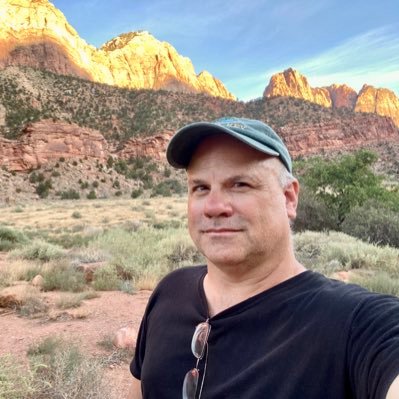
Jonathan Chase @Jon_Chase03
6K Followers 931 Following Ecologist; Biodiversity Synthesis Professor @idiv and @UniHalle; Senior Editor @Ecology_Letters; Dad
Jean-Philippe Lessard... @bugEcology
2K Followers 1K Following Ecologist working on biodiversity-related questions | Insects, climate change, ecosystems | Editor in Chief @ESAMonographs | @bugecology.bsky.social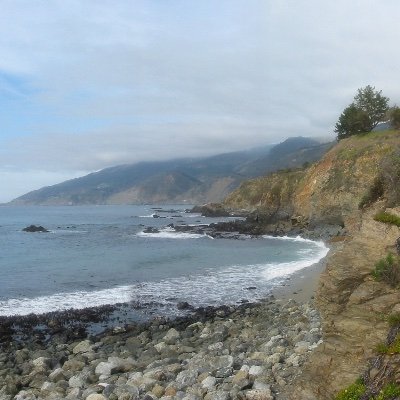
Biogeography.News @JBiogeography
12K Followers 42 Following Journalling on biogeographical research and publishing to foster more equitable and sustainable, adaptive, natural, and research ecosystems globally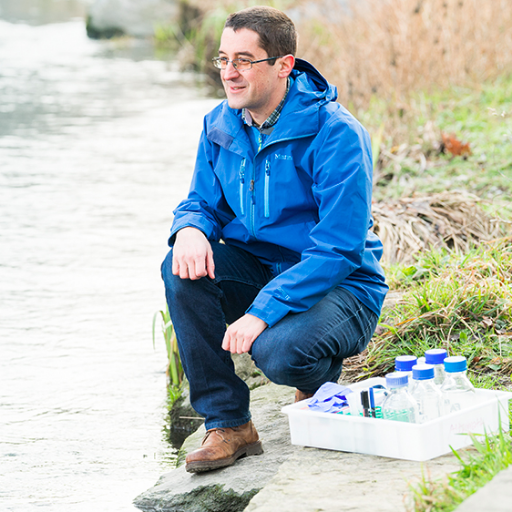
Florian Altermatt @fl... @altermatt_lab
4K Followers 2K Following Full Professor @UZH_Science @EawagResearch | NO LONGER ACTIVE HERE ON X, FIND ME ON BLUESKY @florianaltermatt.bsky.social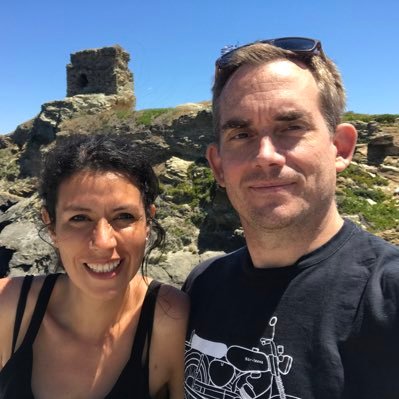
Dylan Craven @DylanJCraven
4K Followers 4K Following plant ecologist flirting with biogeography, Universidad Mayor (GEMA) and @DataObsCL, Rasgos-CL (https://t.co/pPyNQpbvQo), he/him/él, #BlackLivesMatter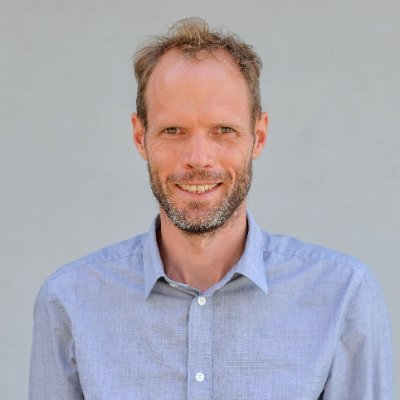
Petr Keil @R_you_cereal
1K Followers 226 Following Researcher at Faculty of Environmental Sciences, Czech University of Life Sciences in Prague. Double dad, synthesizer nerd, runner. 🇺🇦🏳️🌈🇪🇺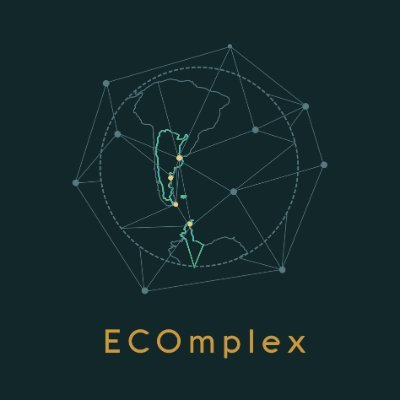
ECOmplex Lab @ecomplex_lab
645 Followers 227 Following Ecology and Complex Systems research group @CadicUshuaia | @ungsoficial @INEDES1 | @CONICETCenpat Account manager: @tomimarina1
Pınar Akbaba (yeni h... @pinaraakbaba
114 Followers 458 Following Biologist | PhD stud. & TA @ Koc University, Molecular Biology & Genetics | Formerly @ METU & Istanbul University | https://t.co/melZJXfBgO
Birdie Bauch @BauchBirdi44764
48 Followers 3K Following
Mar Bernal @marbflo
0 Followers 27 Following
James Williams @KTatlitug42187
72 Followers 696 Following
hammad @ulluboltahai
246 Followers 2K Following formerly ullu. or maybe i still am? ecology, conservation, birds and a wee bit of everything. looking for graduate positions | نمی دانم
Jairsarsl @Jairsarslf1CIk
79 Followers 1K Following
xiaoxiao @rrlixiao2025
0 Followers 9 Following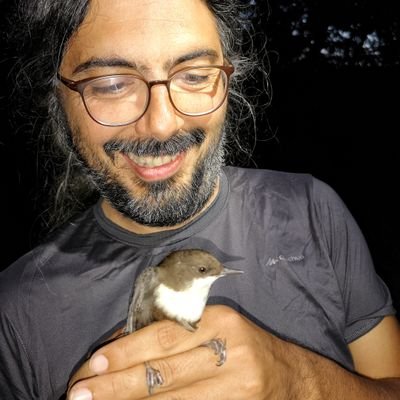
Emrah Çoraman @coraman
45K Followers 3K Following 🦇 Doğa bilimci - Asst. Prof. @itu_aybe İTÜ Avrasya Yer Bilimleri Enstitüsü Ekoloji ve Evrim Anabilim Dalı | Visiting scientist @MfNBerlin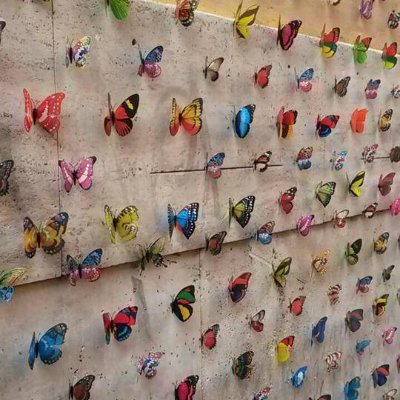
Erika Paez 🦋🦋 @ErikaPV03
114 Followers 328 Following PhD in Evolutionary Biology Ecology | Evasive mimicry |🦋 | she/her | UIO - 🇪🇨
Thyago Miranda @ThyagoMiranda18
208 Followers 682 Following Pai, Marido e filho Doutor em Biodiversidade e Biotecnologia Pesquisador Bolsista no Instituto Tecnológico Vale
Kevin Joel Palmera Ca... @KevinPalme15750
1 Followers 6 Following PhD students🇨🇴🇧🇷 Orchid Bees | Chemical Ecology | Biodiversity
Alex Musyoki @alecksers
50 Followers 373 Following Pollination ecologist with a skewed attention to Moths, butterflies and bees.
Olivera Stamenković_... @OliveraStamen11
42 Followers 149 Following PhD, Researcher focusing on human impact on biodiversity of small lentic water bodies ׀ ponds, macroinvertebrates, community ecology, biodiversity ׀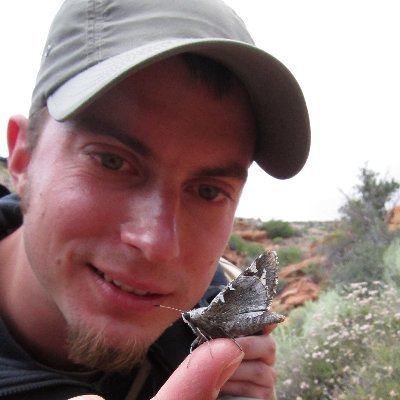
Arne Weinhold 🐧 @pundemics
310 Followers 709 Following Microbial Molecular Ecologist 🧫 | Butterfly Microbiota 🦋 | Microbiome Assembly 🦠| @LMU_Muenchen ex @MPI_CE @fubcp 👉 https://t.co/Zx7kLaGKXD
Isabel Kilian Salas@i... @IsaKilianSalas
157 Followers 396 Following former PhD @Leibniz_LIB & @UniBonn | 🐝🪰pollinator networks #GBOL & 🪱soil biodiversity in #DüNaMeD |#LatinasInStem🇪🇨 |now on BlueSky🦋: @isakiliansalas
Ian McFadden @ian_mcfadden_
1K Followers 2K Following 🌿 Global community ecologist, Californian 📍 Group leader, Queen Mary Uni of London 🌎 Studying biodiversity from local to global
Abdul Saboor khan @Abdubidopsis
1K Followers 6K Following PhD defended at @MeauxJuliette lab @UniCologne. Plant physiological and genetic response to abiotic stresses |MicroRNAs are amazing. ECR @sfb_trr341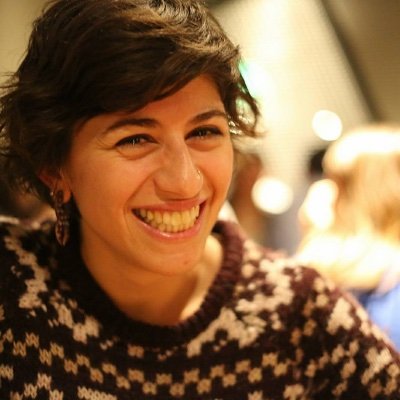
Esra Ergin @esraergin
702 Followers 2K Following Ph.D. @itu_aybe Institute of Earth Sciences, Paleovegetation changes 🌿Botanist, nature photographer, runner, rock climber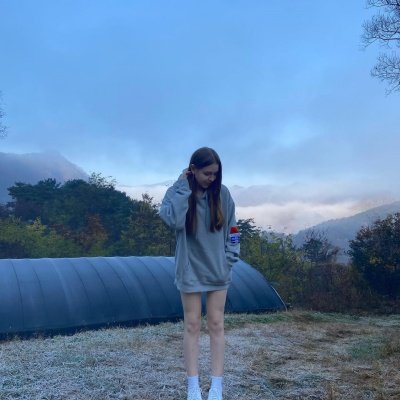
Jill @ShawlurfTX
8 Followers 499 Following Many people say that marriage is the grave of love, but love that can be buried in the earth is better than that on the streets of murderers.
Martha @TtairthvGUrEf
9 Followers 553 Following Don't expose your wounds to others. There are many people in the world who are not doctors, but salt sprayers.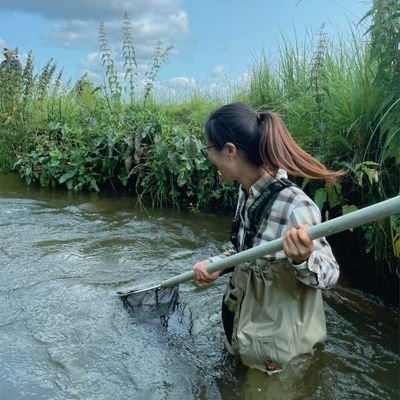
Yingqiu Zhang 张迎�... @zhang_yingqiu
69 Followers 392 Following A researcher working on marine and freshwater fish movement and trophic ecology.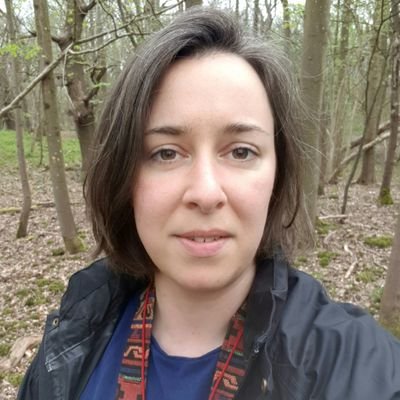
Mia Croft @MiaCroftEnto
144 Followers 357 Following (she/they) PhD Researcher @UniofNewcastle @ecology_ncl @ForagingEcology investigating impacts of artifical light at night on networks 🧬🔬🌿🐛🐞🕷
Shreya Bose @basushreya30
4 Followers 200 Following Wildlife Biologist | JRF @SFRI | Postgraduate in Zoology, WBSU| Passionate about species conservation and ecological research | Volunteer @WWFIndia
Pedram @pedram_ghrm
10 Followers 117 Following Biologist. Marine ecology, mangrove biodiversity researcher at @UnivOfTehran
Poppy Romera @poppyromera1
8 Followers 100 Following
International Union f... @IUAF_forestry
246 Followers 1K Following The home for agroforesters worldwide
Yuzhan Yang @Yuzhan1989
15 Followers 128 Following
Gerardo Betancourt @PhDviews
157 Followers 1K Following PhD Candidate in Social Work, University of Toronto. I have completed training in Education, Law, Health, and Critical Perspectives as LGTBQ Artist/Activist.
Mengesha Asefa @MengeshaAsefa1
22 Followers 147 Following
Akshay Varu @akshayvaru1003
186 Followers 6K Following Data Scientist turned Biologist | Masters in Stem Cell Biology | Marathon Runner
Krizler Tanalgo 👨�... @tkrizler
1K Followers 2K Following Full Professor and Chair @ USM BioDept 👨🏻💻• Bats 🦇 • Conservation • Ecology• Chinese Academy of Sciences 🇨🇳• Zukunftskolleg fellow 🇩🇪
Izadora N. Gonzalez @nardizadora
424 Followers 912 Following MSc student in Ecology at @unicampoficial Crazy for outdoors, wildlife photography and whatever else i'm into at the moment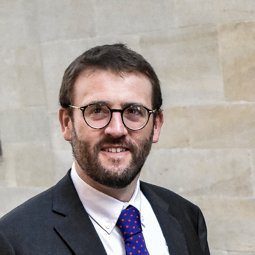
Sebastian Davis @sidavisb
199 Followers 6K Following Sustainability | Governance. Trust is built in complexity. Engagement ≠ Alignment.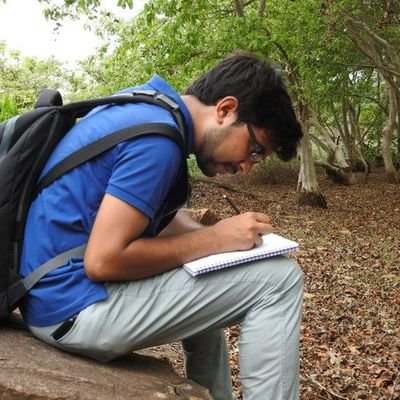
Paul Pranesh @paul_pranesh
65 Followers 410 Following PhD @uniOFcalcutta | Ecologist | Exploring the intersections of biodiversity, invasive species, conservation, and environmental remediation |
Linqing Yang @LinqingYang
74 Followers 569 Following Postdoctoral researcher @UofUBiology @WilkesCenter
ChaoChang @micobiome
53 Followers 336 Following An environmental science PHD candidate. I have a great interest in community ecology. My current research is to use eDNA technology to study the river basins.
Paola Barajas Barbosa @Paola_barbarbo
857 Followers 903 Following Biologist & geo-ecologist 🇨🇴 I investigate what drives biodiversity patterns & change. Functional ecology 🌿 | Postdoc @iDiv BioSyn Group | PhD @BioGeoMacro
Barbara Nuic @Barbara_Nuic
104 Followers 155 Following PhD candidate investigating fish physiology @UQ @Franklin_EcoLab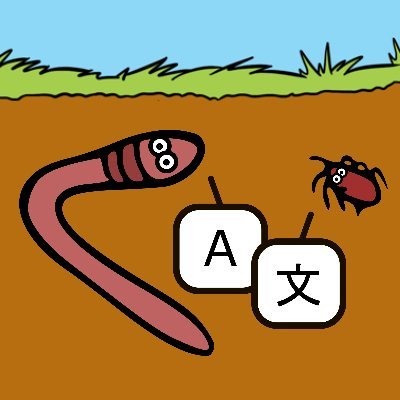
Translating SoilBiodi... @soilbio_comm
100 Followers 121 Following #soilbiodiversity article #translations = work of more than 50 #scientists and Young Reviewers worldwide & voluntary #ecologists! #scicomm #science #soil @iDiv
@smartenwinter.bsky.s... @sMarten_Winter
4K Followers 4K Following Ecologist | Head of iDiv's Synthesis Centre sDiv https://t.co/amXvLFoiDQ | https://t.co/HexIoHT60X | Highly Cited | TEDx https://t.co/gNw4C4tXdw| Drums https://t.co/7JwW3Ve8XS
Journal of Animal Eco... @AnimalEcology
27K Followers 384 Following A dedicated forum for the best original research in #AnimalEcology. A @BritishEcolSoc journal.
iDiv Biodiversity Res... @idiv
10K Followers 475 Following German Centre for Integrative Biodiversity Research (iDiv). Posts by iDiv’s Media & Communications unit. Imprint: https://t.co/nuf0cnroer
Fernando T. Maestre @ftmaestre
13K Followers 736 Following Professor of Environmental Science and Engineering @KAUST_news Husband, father, dryland ecologist & runner. PI @Maestrelab
Matthias C. Rillig @mrillig
15K Followers 1K Following Professor (Ecology) ML MAE, FU Berlin | soil | fungi | biodiversity | mycorrhiza | global change | microplastic | AI effects | YouTube: Life in Academia
Oscar Godoy @Eco_Godoy
3K Followers 1K Following Ecologist working on biotic interactions, multitrophic coexistence, and ecosystem functioning across terrestrial and marine systems #ecology @ebdonana @CSIC
Pete Manning @PeteEcology
4K Followers 2K Following Professor of Ecology, studying biodiversity, the functioning of ecosystems and the benefits they bring @UiB
Jens Svenning @JCSvenning
11K Followers 2K Following Scientist: #macroecology, #biodiversity, #climatechange, #restoration & #rewilding, #human-#nature relations & #remotesensing. https://t.co/7Ylw5Z3Uw4
Ecography @EcographyJourna
16K Followers 1K Following An outlet for empirical/theoretical work in spatial and temporal #ecology, #macroecology and #biogeography. Owned by the @NordicOikos Society. #OpenAccess
British Ecological So... @BritishEcolSoc
43K Followers 1K Following Pioneering research, convening government & nurturing next-gen ecologists🌱 Follow us on Bluesky: https://t.co/RRwDkMlBuh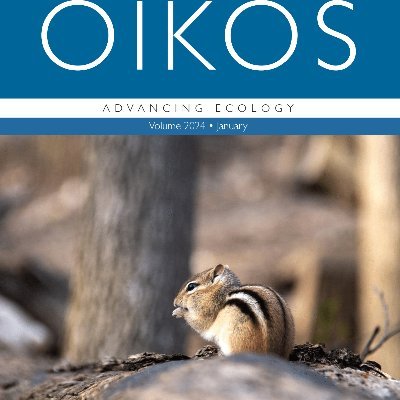
Oikos @Oikos_Journal
15K Followers 146 Following One of the leading peer-reviewed journals in #ecology, owned by @NordicOikos. Publishes research papers where different aspects of ecology are brought together.
Andy Gonzalez @bio_diverse
8K Followers 1K Following Biodiversity scientist | Liber Ero Chair @McGillU | co-Chair @GEOBON_org | co-Dir. @csbq_qcbs | cofounder @habitat_nat | Dad x2 | @[email protected]
Henrique Pereira @hmlfpereira
4K Followers 940 Following Professor of biodiversity conservation @iDiv @UniHalle, invited researcher @CIBIO_InBIO 🇵🇹🇩🇪🇪🇺
Anton Potapov @AntonCollembola
1K Followers 497 Following 🇺🇦🧍❤️🩹🧍🇷🇺 | Re-visioning soil food webs at Senckenberg Görlitz | @idiv | #SoilBON https://t.co/8qO6ZFgUlF | #GlobalCollembola | https://t.co/IdsDReWLcf
Dr Sam Ross @SamRPJRoss
2K Followers 795 Following Staff Scientist @oistedu 🇯🇵 | response diversity, ecological stability, ecoacoustics | via @TCDZoology 🇮🇪 @LeedsEcoEvo 🇬🇧 | 🇪🇺🏳️🌈 he/him
Jonathan Chase @Jon_Chase03
6K Followers 931 Following Ecologist; Biodiversity Synthesis Professor @idiv and @UniHalle; Senior Editor @Ecology_Letters; Dad
Global Change Biology @GlobalChangeBio
18K Followers 222 Following Global Change Biology is a journal that exists to promote understanding of the interface between all aspects of environmental change & biological systems.
Biogeography.News @JBiogeography
12K Followers 42 Following Journalling on biogeographical research and publishing to foster more equitable and sustainable, adaptive, natural, and research ecosystems globally
Florian Altermatt @fl... @altermatt_lab
4K Followers 2K Following Full Professor @UZH_Science @EawagResearch | NO LONGER ACTIVE HERE ON X, FIND ME ON BLUESKY @florianaltermatt.bsky.social
Petr Keil @R_you_cereal
1K Followers 226 Following Researcher at Faculty of Environmental Sciences, Czech University of Life Sciences in Prague. Double dad, synthesizer nerd, runner. 🇺🇦🏳️🌈🇪🇺
David García Calleja... @callejas_eco
448 Followers 636 Following ecologist working on interaction networks & community ecology. Inactive profile, moved to bluesky: @callejas.bsky.social
Susanne Kortsch @SusanneKortsch
334 Followers 535 Following Food Web Ecologist | University researcher @HelsinkiUni BlueSky: https://t.co/5jtHq8EUQ5 https://t.co/bOngOPn6sy
HIFMB 🪼 @hifmb.bsk... @HIFMB_OL
1K Followers 437 Following HIFMB develops the scientific basis for marine conservation & marine ecosystem management by analysing the functional role of biodiversity in marine ecosystems.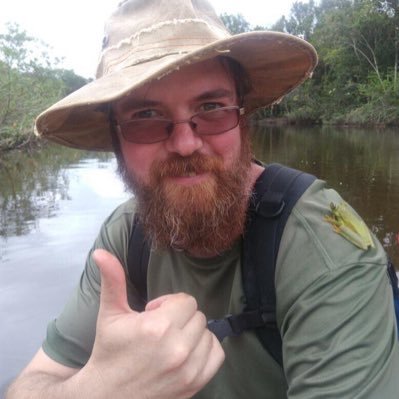
Gustavo Q Romero @gqromero
834 Followers 829 Following Professor at State University of Campinas. I study ecology, evolution, rainforests, conservation, food webs, climate change. he/his
MultiTroph @MultiTroph
81 Followers 69 Following Multitrophic interactions in a forest biodiversity experiment in China | https://t.co/bJQko0W8eB | #eXit | Now on #Bluesky #Instagram and #Mastodon!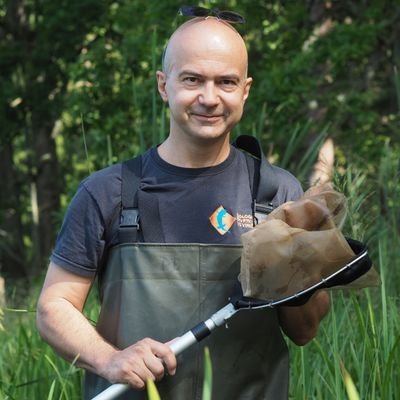
David Boukal @davidb_cz
274 Followers 596 Following Mostly aquatic ecologist, modeller & occassional photographer. Wild East, south of Prague. Professor @JihoceskaUni @BiologyCentre https://t.co/TmhYJ3YYLs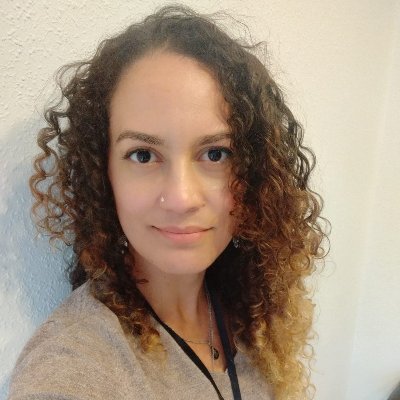
Talita Amado @amadotalita
296 Followers 455 Following PhD in Macroecology and macroevolution. Scientific illustrator, Latina in STEM.
Alan Hastings @eco_hastings
238 Followers 44 Following Theoretical ecologist/mathematical biologist at UC Davis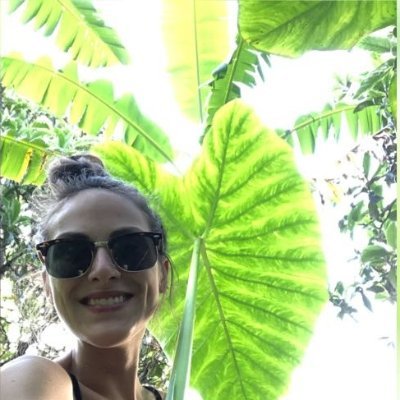
Friederike J.R. Wölk... @FriederikeWolke
69 Followers 124 Following PhD student in Biodiversity Modeling | universal patterns of biodiversity change @fzpczu | macroevolution of plant traits @iDiv | Prague | #fcknzs
Angie L Peace @AngieLPeace
104 Followers 80 Following applied mathematician, ecological modeler, mother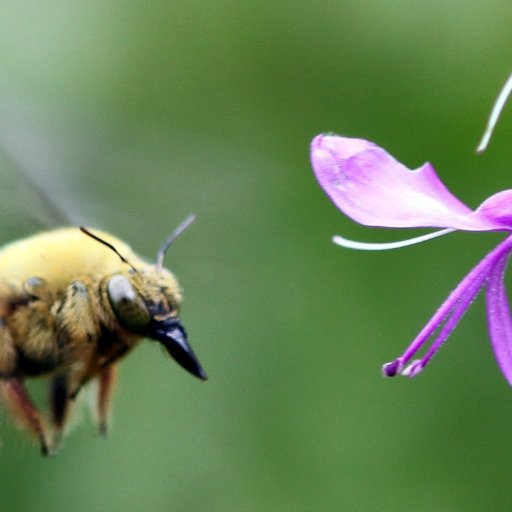
Insect Community Ecol... @GroupInsect
851 Followers 539 Following Ecological entomology research at Faculty of Science @science_charles and @BiologyCentre, Czech Republic. Led by @RobertTropek #ICEG
Brandon Barton @TrophicCascader
1K Followers 838 Following Dad; Ecologist; Outdoorsman; Educator; Mentor; Editor-In-Chief; musician; he/him
Sci-Hub @sci_hub_
117K Followers 0 Following
Steven Strogatz @stevenstrogatz
164K Followers 3K Following Mathematician, writer, Cornell professor. All cards on the table, face up, all the time.
KratinaLab @KratinaLab
479 Followers 649 Following We get excited about diversity, food webs and trophic ecology and study climate warming, microplastics and habitat degradation @qm_sbcs @qmul
KateWootton @KateWootton2
91 Followers 38 Following Postdoc @ University of Canterbury, NZ | Ecological networks | Trail running | She\her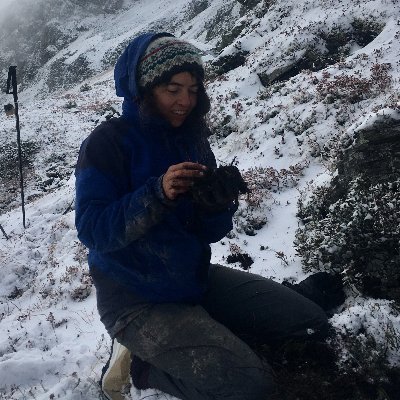
Irene Calderón Sanou @CalderonSanou
155 Followers 392 Following Ecologist. Passionate by the diversity of the visible and "invisible" living world.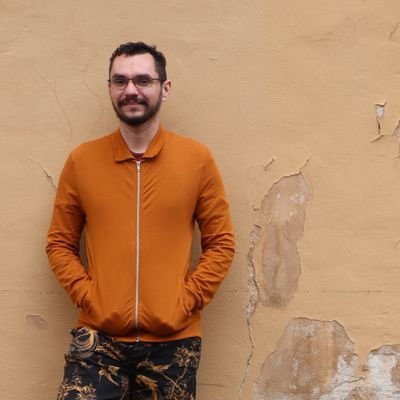
Juliano Sarmento Cabr... @cabral_sarmento
1K Followers 1K Following Biologist. #biodiversity #ecol #evol #biogeogr. Prof for ecological modelling @UniBonn. Senior editor @consbiog. he/him 🏳️🌈 🇧🇷🇩🇪 opinions my own
Wentao Yu @PandaWYu
25 Followers 78 Following MSc graduate in biology with keen interest in computational biology, bioinformatics, molecular ecology, evolutionary biology, spatial analysis, marine biology.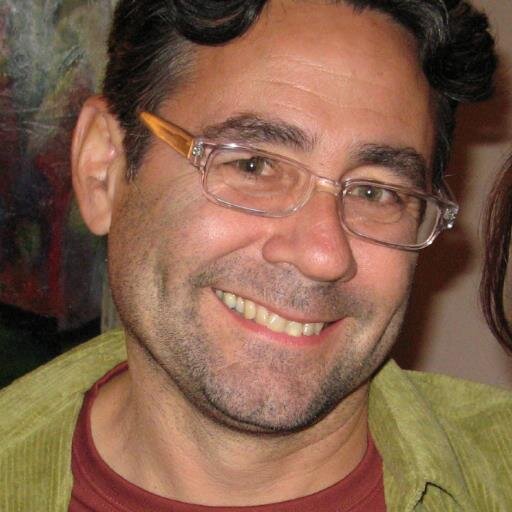
Neo Martinez @neodmartinez
59 Followers 23 Following ecologist, network scientist, declarer of interdependence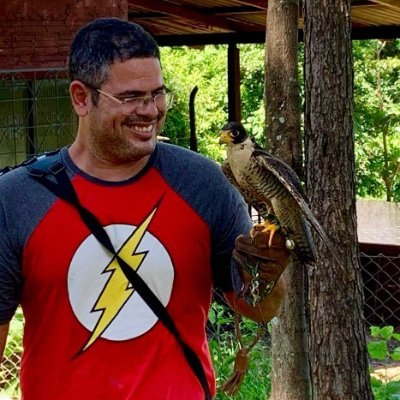
Paulo Guimaraes @paulo_prguima
1K Followers 615 Following Alice and Marina's dad. Professor at @usponline. Ecology, evolution, and networks. Brazilian Jiu-Jitsu & Judo practitioner. Comics, Birding & Beer lover.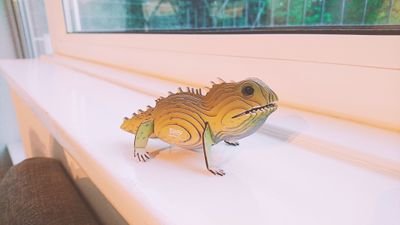
Hsi-Cheng Ho @HsiChengHo
228 Followers 180 Following Empirical/theoretical ecologist exploring behaviours × ecological networks. Assit. Prof at NTU (Taiwan). Former Postdoc at Eawag & PhD from Imperial College.
joerdis_terlau @JoerdisTerlau
9 Followers 27 Following![Spatial community ecology in highly dynamic landscapes: from island biogeography to metaecosystems.
[DFG Research Unit FOR 2716]](https://pbs.twimg.com/profile_images/1192534394248011776/p_WdPJrS.jpg)
DynaCom @DynaComProject
162 Followers 33 Following Spatial community ecology in highly dynamic landscapes: from island biogeography to metaecosystems. [DFG Research Unit FOR 2716]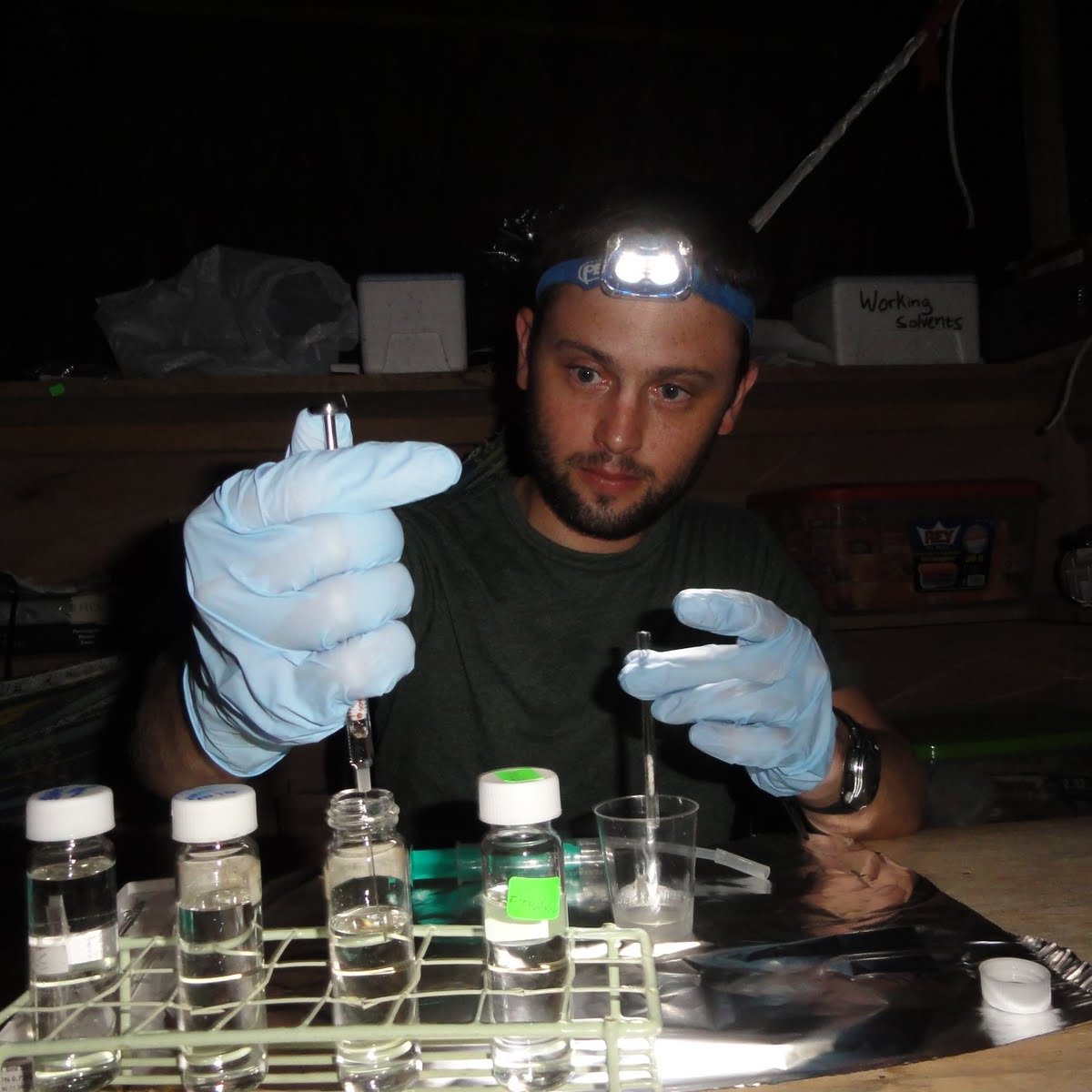
Omer Nevo @ONevo_EvolEcol
272 Followers 531 Following Evolutionary ecologist. Specializing on the chemistry of fruit scent and its role in animal-plant communication.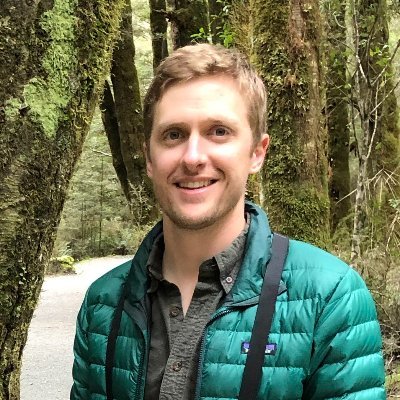
Evan Fricke @ecfricke
889 Followers 638 Following Ecologist studying biodiversity, seed dispersers, forest regeneration, and climate change @MIT, he/him, @efricke.bsky.social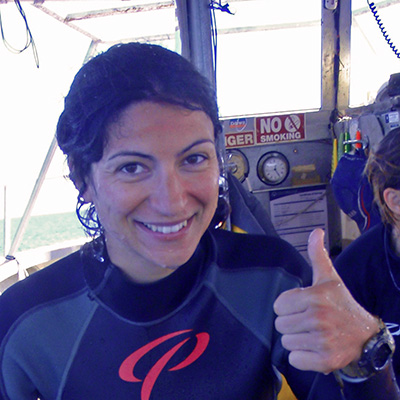
Ana MM Sequeira @AnaMMSequeira
1K Followers 249 Following Research Director & Lead Coordinator of https://t.co/oOfJP6owUl Pew Marine Fellow 2020 https://t.co/PXSrTjzNGz Assoc Prof @EcoEvo_ANU 🐳🦈🐬🐢
Emese Xóchitl Szabó @EmeseXochitl
91 Followers 295 Following An enthusiastic and curious Biostatistician. Always searching for unique solutions to answer important questions of life.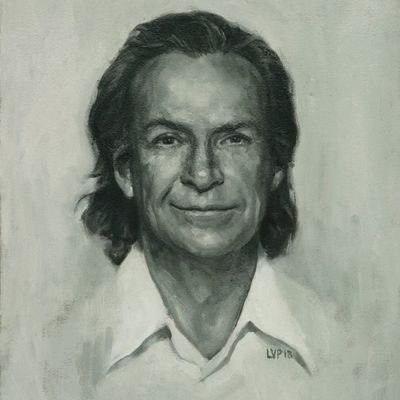
Prof. Feynman @ProfFeynman
1.4M Followers 0 Following A universe of atoms, an atom in the universe. Tribute to the great explainer. Tweets about Science and Wisdom. Portrait by L.V Patten.
Ring of Fire @Arctic_Biology
109 Followers 163 Following The Ring of Fire is a £3.7m #NERC Large Grant investigating global warming in 5 Arctic geothermal systems: Iceland, Greenland, Alaska, Kamchatka, and Svalbard.
BCB Japan @bio_cb_japan
582 Followers 742 Following Biodiversity and Conservation Biogeography of Japan, University of the Ryukyus. Yasuhiro Kubota Lab. https://t.co/IacrRWTArT
Alexander Zizka @BiodivRsity
987 Followers 565 Following Biogeographer, Botanist and R-enthusiast. PI of the "Biodiversity of plants" lab at Philipps-University Marburg. Also: 🤽♂️. @[email protected]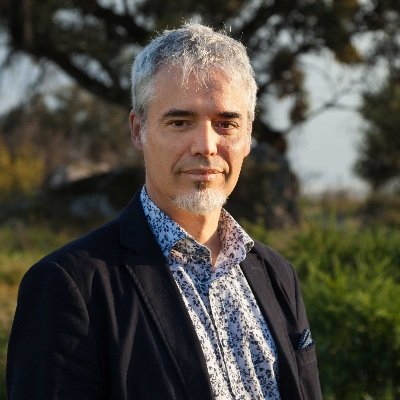
Miguel Araújo @Araujo_lab
5K Followers 37 Following I no longer post on this account. Just use to follow and comment international news. You can find me on Bluesky, LinkedIn, and Facebook.
Moreno Di Marco (m-di... @m_dimarco
1K Followers 731 Following Dad, husband, scientist #biodiversity #globalchange #sustainability, rock climber. Assoc Prof @SapienzaRoma, Editor @ConBiology. bsky: https://t.co/8jWIQZg3jn
Bernd Blasius @BerndBlasius
184 Followers 94 Following I work at the description of complex living systems at the interface of theoretical ecology and applied mathematics.
Oskar Hagen @hagen_oskar
956 Followers 1K Following 🖖Evolutionary Biologist and Ecologist 🚧PostDoc @iDiv 🐦#EcoEvo #modelling #macroevolution #macroecology #biodiversity 🦣 @[email protected]
🪲 @NBluthgen
990 Followers 333 Following Inactive. Moved here: https://t.co/yACLYzQBQg and here: https://t.co/Y6tX63sCD2
Matías Arim @matiasarim
285 Followers 296 Following Ecologo, CURE-UdelaR. Estructura y funcionamiento de la diversidad biológica. Ecology-Structure and function of biodiversity
Rafael Pinheiro @rafabppinheiro
563 Followers 412 Following Doutor pela @ufmg. Biologia, ecologia, ciência! PhD by UFMG. Biology, ecology, science!